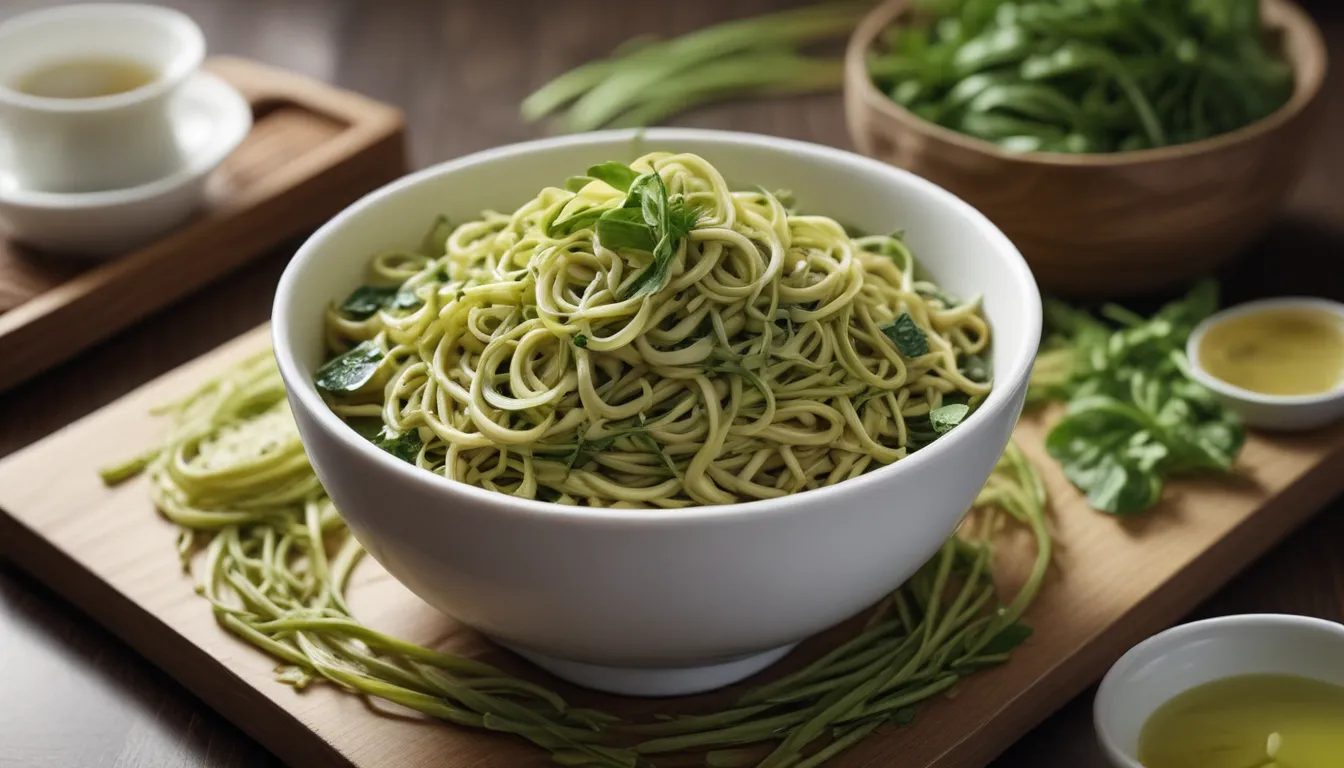The pictures in our articles might not always show exactly what the text is talking about. We use these images to make the article more interesting and eye-catching. They are there to add to the text, but not to replace it or show every detail.
If you're a noodle enthusiast looking to expand your culinary horizons, green tea noodles should definitely be on your radar. These vibrant and flavorful noodles, also known as matcha soba, offer a unique twist to your regular pasta routine. Made by combining wheat flour and powdered green tea, green tea noodles not only add a splash of color to your dish but also pack a punch of health benefits.
In this article, we'll delve into the fascinating world of green tea noodles, exploring their origins, nutritional value, culinary versatility, and more. Whether you're a foodie eager to embark on new gastronomic adventures or a health-conscious individual seeking nutritious alternatives, let's uncover the secrets of green tea noodles together.
The Journey of Green Tea Noodles: Origin and History
Green tea noodles, also known as matcha soba, have a rich history dating back to Japan's Edo period. These noodles were ingeniously crafted to infuse the health benefits of green tea into a versatile and delectable dish. The fusion of tradition and innovation has given rise to a culinary gem that continues to captivate taste buds around the world.
Unveiling the Magic of Matcha: Made with Matcha Powder
The distinctive green color and earthy flavor of green tea noodles are attributed to matcha powder. This finely ground green tea powder not only lends a vibrant hue to the noodles but also adds a layer of antioxidant-rich goodness. With matcha as a key ingredient, green tea noodles offer a unique and irresistible taste experience.
A Nutrient-Packed Delight: Health Benefits of Green Tea Noodles
Green tea noodles are not just visually appealing; they also boast a plethora of health benefits. Low in calories and high in fiber, these noodles are a source of essential nutrients like vitamins, minerals, and antioxidants. Additionally, green tea noodles are believed to boost metabolism, aid in weight loss, and promote overall well-being.
Embracing Versatility: Green Tea Noodles in Culinary Creations
The culinary uses of green tea noodles are as diverse as they are delightful. Whether enjoyed cold in salads or served hot in soups and stir-fries, these noodles lend themselves to a myriad of creative dishes. From pairing with vegetables and tofu to meat and seafood, the versatility of green tea noodles knows no bounds.
A Symphony of Flavors: Unique Flavor Profile of Green Tea Noodles
The marriage of matcha's earthy notes and the mild flavor of traditional noodles creates a harmonious blend of tastes in green tea noodles. With a subtly sweet and slightly bitter flavor profile, these noodles serve as a canvas for various sauces and seasonings, offering a symphony of flavors in every bite.
Catering to All: Gluten-Free Option for Green Tea Noodles
For individuals with gluten sensitivities or celiac disease, green tea noodles provide a gluten-free alternative to traditional wheat-based noodles. Typically made from buckwheat flour or a combination of buckwheat and wheat flour, these noodles ensure that everyone can savor their delicious offerings.
Nurturing Digestive Health: Green Tea Noodles and Digestion
The fiber content present in green tea noodles plays a vital role in promoting digestive health. Regular consumption of these noodles can aid in regulating bowel movements, preventing constipation, and nurturing a healthy digestive system. With each slurp of green tea noodles, you're nourishing your body from the inside out.
Harnessing the Power of Antioxidants: Source of Antioxidants in Green Tea Noodles
Green tea noodles are a treasure trove of antioxidants, courtesy of the matcha powder used in their preparation. These antioxidants serve as warriors against free radicals, helping to protect the body from oxidative damage and reducing the risk of chronic diseases. A bowl of green tea noodles is not just a meal; it's a nourishing ally for your health.
Culinary Convenience: Easy Preparation of Green Tea Noodles
Cooking green tea noodles is a breeze, requiring just a few simple steps. Boil the noodles in water until tender, then rinse with cold water before incorporating them into your desired dish. With minimal effort and maximum flavor, green tea noodles make meal prep a joy.
Woven into Tradition: Green Tea Noodles in Japanese Cuisine
Green tea noodles hold a special place in traditional Japanese cuisine, often symbolizing luck and vitality, especially during New Year celebrations. The vibrant green color of these noodles serves as a visual representation of freshness and life, adding a touch of tradition to every meal.
Elevating Aesthetics: Enhancing Presentation with Green Tea Noodles
The striking green hue of green tea noodles elevates the presentation of any dish, turning a simple meal into a culinary masterpiece. Chefs worldwide utilize green tea noodles to create visually stunning and inviting plates that not only please the palate but also delight the eyes. With green tea noodles, every meal is a work of art.
Global Appeal: Popularity of Green Tea Noodles in Asian Fusion Cuisine
Green tea noodles have transcended borders and gained popularity in Asian fusion cuisine, where traditional ingredients meld with global influences. These noodles add a touch of innovation and intrigue to familiar noodle dishes, captivating diners with their unique flavor and visual appeal.
Weaving Nourishment with Satisfaction: Satisfying Experience of Green Tea Noodles
Green tea noodles offer a fulfilling and nourishing dining experience, thanks to their fiber content that keeps you feeling full for longer. With a satisfying chewy texture and a medley of flavors, these noodles provide a comforting meal that satiates both the body and the soul.
Unleashing Creativity: Exploring Creative Recipes with Green Tea Noodles
The culinary canvas of green tea noodles is vast, offering endless opportunities for experimentation. From green tea noodle salads with sesame dressing to green tea soba noodle soups, there are countless recipes waiting to be discovered. By exploring different flavors and ingredients, you can unlock a world of culinary delights with green tea noodles.
Accessible Delights: Availability of Green Tea Noodles
Green tea noodles can be easily sourced from Asian grocery stores, specialty food stores, and online retailers. As their popularity continues to soar, the availability of these noodles is expanding, making it convenient for food enthusiasts to incorporate them into their culinary repertoire.
Celebrating Flavor: Green Tea Noodle Festivals in Japan
In certain regions of Japan, green tea noodle festivals are held to celebrate the allure and deliciousness of these noodles. These festivals showcase a variety of green tea noodle dishes, attracting food enthusiasts from near and far. It's a culinary celebration that honors the rich heritage and flavors of green tea noodles.
Epilogue: Embracing the Magic of Green Tea Noodles
In closing, green tea noodles are not just a culinary delight; they're a celebration of health, flavor, and tradition. With their antioxidant-rich goodness, unique taste profile, and versatile nature, green tea noodles offer a well-rounded dining experience that nourishes the body and delights the senses. Whether you're a seasoned foodie or a novice explorer, green tea noodles beckon you to indulge in a world of culinary wonders.
If you're ready to embark on a culinary adventure with green tea noodles, now is the perfect time to savor the delights they have to offer. Whether you're seeking a healthier alternative to traditional noodles or simply looking to experience new flavors, green tea noodles are a delightful choice that promises a memorable dining experience. So, why wait? Dive into a bowl of green tea noodles and let the journey begin!
Frequently Asked Questions
-
What are green tea noodles?
Green tea noodles are noodles made from a blend of wheat flour and powdered green tea, offering a light green color and a subtle tea flavor. -
Do green tea noodles contain caffeine?
Yes, green tea noodles contain a small amount of caffeine due to the presence of green tea powder, although the caffeine content is lower compared to a cup of green tea. -
Are green tea noodles gluten-free?
No, green tea noodles are typically made with wheat flour and are not gluten-free. However, there are gluten-free alternatives available that use ingredients like rice flour or buckwheat. -
How do I cook green tea noodles?
Cooking green tea noodles is similar to cooking regular noodles. Boil them in water until al dente, then drain and rinse with cold water to halt the cooking process. -
Can I use green tea noodles in any recipe?
Absolutely! Green tea noodles can be substituted in any recipe that calls for regular noodles, adding a unique flavor and color to dishes like stir-fries, soups, and salads. -
Where can I buy green tea noodles?
Green tea noodles can be found in Asian supermarkets, specialty stores, and online retailers, catering to a growing demand for these versatile noodles. -
Are green tea noodles healthy?
Green tea noodles offer a spectrum of health benefits, including high antioxidant content and lower calorie and carbohydrate levels compared to traditional noodles, making them a wholesome choice for health-conscious individuals.
In the realm of culinary exploration, green tea noodles stand out as a beacon of health, flavor, and creativity. As you journey through the world of food and nutrition, let the allure of green tea noodles guide you towards a path of gastronomic delight and wellness. Embrace the magic of green tea noodles, savor their unique flavors, and relish the goodness they bring to your table. Happy noodle adventures await!






